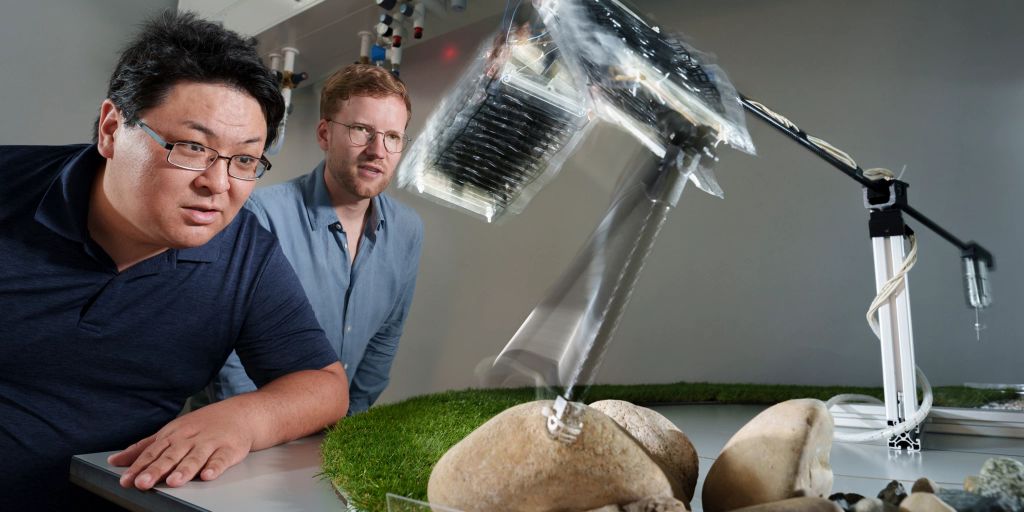Researchers at ETH Zurich have developed a robot leg with artificial muscles. This could make robots more efficient and more agile in the future.
Doctoral students Toshihiko Fukushima (left) and Thomas Buchner (right) observe the movement of the robot leg. – W. Scheible / MPI-IS
The most important things in brief
- Researchers have developed a robotic leg that is powered by artificial muscles.
- The system is more energy efficient than electric motors and enables high jumps.
- The technology offers potential for future applications in soft robotics.
Ad
Researchers at ETH Zurich and the German Max Planck Institute for Intelligent Systems have developed a robot leg that is powered by artificial muscles. The new Swiss technology is more energy efficient than conventional drives. The robot leg can perform high jumps and fast movements as well as detect and react to obstacles.
As in humans and animals, an extensor and a flexor muscle enable the robot’s leg to move. The muscles consist of electrohydraulic actuators, plastic bags filled with oil that are attached to the skeleton via tendons. When the artificial muscle is powered, electrodes push the oil to one side. This causes the bag to shorten, just as a real muscle shortens. Pairs of these actuators attached to a skeleton produce the same muscle movements as in living things: when one muscle shortens, its counterpart lengthens. Computer code controls which actuators should contract and which should lengthen.
The researchers compared the energy efficiency of their robot leg with that of a conventional robot leg powered by an electric motor. They found that their artificial muscles consume much less energy than electric motors.
The jumping ability of the robot leg is based on its ability to lift its own weight explosively. The researchers showed that the robot leg has a high degree of adaptability, which is particularly important for soft robotics. “It’s no different for living beings. If we can’t bend our knees, we have difficulty walking on uneven terrain,” says ETH researcher Robert Katzschmann. While a sensor has to constantly tell the electric motor what angle the robot leg is at, the artificial muscle adapts adaptively through interaction with the environment.
Emerging Swiss technology opens up new possibilities
The research field of electrohydraulic actuators has only existed for around six years. The field of robotics is making rapid progress in control engineering and machine learning. In contrast, progress in robot hardware has so far been minimal, say the researchers. The new Swiss technology is also not yet ready for practical use: “The current system is still limited compared to walking robots with electric motors. Currently, the leg is attached to a rod and cannot move freely,” reports Katzschmann.
Future work should overcome these limitations so that real walking robots with artificial muscles can be developed. “If we combine the technology of the robot leg to create a four-legged robot or a humanoid robot with two legs, we can one day use it as a rescue robot,” says the ETH researcher.
More on the topic:
ETH ZurichRoboticsEnergySwiss Technology


